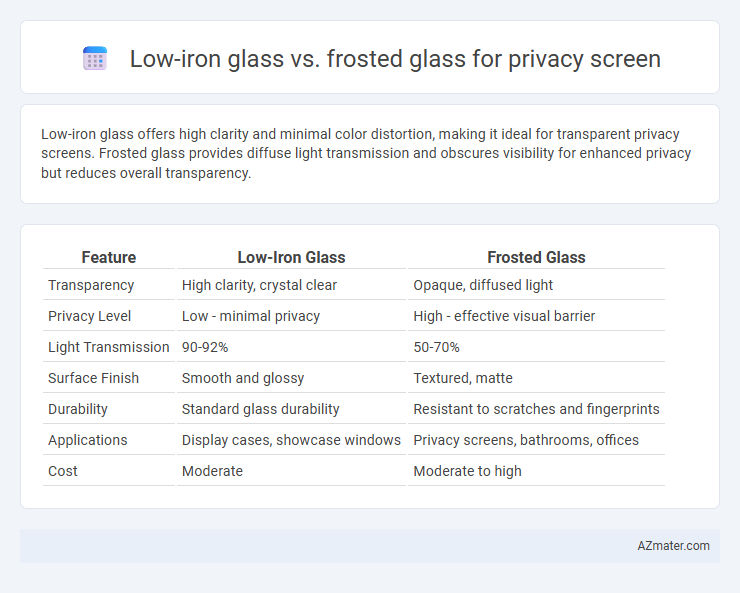Low-iron glass offers high clarity and minimal color distortion, making it ideal for transparent privacy screens. Frosted glass provides diffuse light transmission and obscures visibility for enhanced privacy but reduces overall transparency.
Table of Comparison
| Feature | Low-Iron Glass | Frosted Glass |
|---|---|---|
| Transparency | High clarity, crystal clear | Opaque, diffused light |
| Privacy Level | Low - minimal privacy | High - effective visual barrier |
| Light Transmission | 90-92% | 50-70% |
| Surface Finish | Smooth and glossy | Textured, matte |
| Durability | Standard glass durability | Resistant to scratches and fingerprints |
| Applications | Display cases, showcase windows | Privacy screens, bathrooms, offices |
| Cost | Moderate | Moderate to high |
Introduction: Understanding Privacy Screen Solutions
Low-iron glass offers enhanced clarity and brightness, making it ideal for privacy screens where visual quality is essential. Frosted glass provides a diffusion effect that obscures visibility while allowing light to pass through, ensuring privacy without sacrificing illumination. Choosing between low-iron and frosted glass depends on the balance needed between transparency and privacy in architectural and interior applications.
What is Low-Iron Glass? Key Characteristics
Low-Iron Glass is a type of glass with reduced iron content, resulting in higher clarity and minimal greenish tint compared to standard glass, making it ideal for applications requiring pristine transparency. It features superior light transmission, typically around 91%, and enhanced color accuracy, which benefits privacy screens by maintaining visibility while providing a clean, modern look. Unlike Frosted Glass, which obscures visibility through textured or sandblasted surfaces, Low-Iron Glass prioritizes clarity without sacrificing privacy when combined with films or coatings.
What is Frosted Glass? Main Features Explained
Frosted glass features a textured or sandblasted surface that diffuses light, providing privacy while allowing natural illumination to pass through. Unlike low-iron glass, which offers higher clarity and a green-free appearance, frosted glass obscures visibility, making it ideal for privacy screens in offices and bathrooms. Its main characteristics include reduced transparency, light diffusion, and a decorative matte finish that enhances both functionality and aesthetics.
Clarity Comparison: Visual Transparency Differences
Low-iron glass offers superior clarity with minimal greenish tint, providing excellent visual transparency ideal for privacy screens that require both clear views and subtle concealment. Frosted glass diffuses light through its textured surface, significantly reducing visibility and creating a blurred effect that prioritizes privacy over clarity. When comparing clarity, low-iron glass maintains sharp, true-to-color images, whereas frosted glass prioritizes obscured visuals for enhanced privacy at the expense of transparency.
Privacy Levels: Low-Iron vs. Frosted Glass
Low-iron glass offers moderate privacy by providing enhanced clarity and true color representation, allowing light transmission while obscuring detailed views. Frosted glass delivers higher privacy levels by diffusing light and blurring visibility, effectively preventing any clear sight through the surface. For applications requiring superior visual obstruction, frosted glass is the preferred choice over low-iron glass.
Aesthetic Appeal and Design Flexibility
Low-iron glass offers superior clarity and a near-transparent appearance, making it ideal for enhancing aesthetic appeal in privacy screens with a modern, sleek design. Frosted glass provides versatile design flexibility through customizable opacity and patterns, allowing for creative privacy solutions that blend functionality with artistic expression. Both materials cater to different stylistic preferences, with low-iron glass emphasizing minimalism and frosted glass enabling subtle diffusion of light and privacy.
Durability and Maintenance Requirements
Low-iron glass offers superior clarity and strength, making it highly durable against scratches and impacts, requiring minimal maintenance to retain its pristine appearance. Frosted glass, while providing excellent privacy through its opaque surface, is more prone to surface damage such as scratches and stains, necessitating regular cleaning with non-abrasive agents to maintain its look. Both materials are resilient, but low-iron glass generally demands less upkeep and offers longer-lasting durability for privacy screens.
Light Transmission and Energy Efficiency
Low-iron glass offers superior light transmission of up to 91%, making it ideal for applications requiring maximum natural light while maintaining clarity. Frosted glass significantly reduces light transmission to around 60-70%, enhancing privacy by diffusing light but sacrificing some brightness. In terms of energy efficiency, low-iron glass supports passive solar heating due to its high transparency, while frosted glass improves insulation by diffusing sunlight, reducing glare and heat buildup indoors.
Cost Considerations: Which is More Affordable?
Low-iron glass typically costs more due to its higher purity and clarity, making it a premium choice for privacy screens. Frosted glass, created through sandblasting or acid etching, is generally more affordable and widely available. For budget-conscious projects, frosted glass offers a cost-effective privacy solution without sacrificing functionality.
Choosing the Right Glass for Privacy Screens
Low-iron glass offers exceptional clarity with minimal green tint, making it ideal for privacy screens where both visibility and subtle privacy are needed. Frosted glass provides a more opaque surface that diffuses light and obscures vision, enhancing privacy without sacrificing natural light. Selecting the right glass depends on the desired balance between transparency and privacy, with low-iron glass suited for clear but private views and frosted glass for maximum visual obstruction.

Infographic: Low-iron glass vs Frosted glass for Privacy screen
 azmater.com
azmater.com